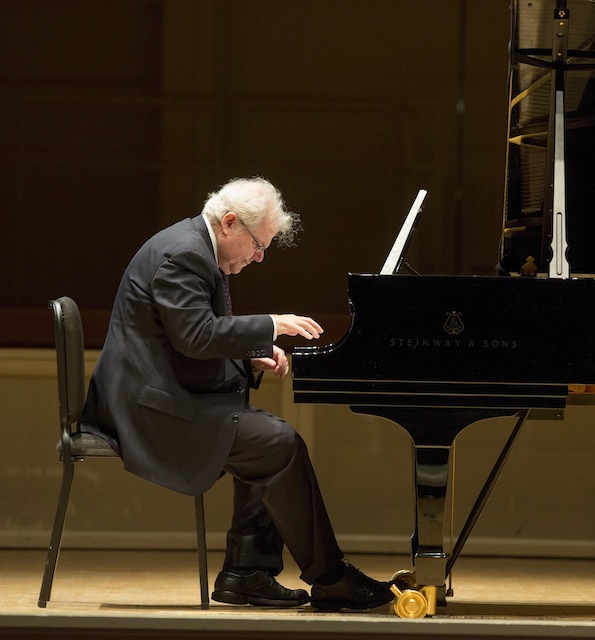Emanuel Ax gracefully reveals the once and future Brahms

Emanuel Ax performed the final program of his Brahms Project Sunday afternoon at Symphony Center. Photo: Todd Rosenberg.
The third and final program of Emanuel Ax’s “Brahms Project” series in Chicago concluded Sunday afternoon at Symphony Center with a solo recital by Ax. The premise has been to juxtapose works of Brahms with performances of newly commissioned works that reflect his influence.
The performance of Brahms’ Sonata No. 2 in F-sharp minor, Op. 2 that began the program was revelatory on a number of levels. It is a rarely performed youthful work, written when Brahms was 19 and still under the influence of music and styles surrounding him, particularly Beethoven and Liszt. As such, it gives us a glimpse of Brahms in artistic development. And yet, already there is a musicality and a confidence, indeed, a swagger, that reveals a presence to be reckoned with.
Ax chose to emphasize the work’s youthful brilliance, to be sure, but this is a work that never exploits pianism for its own sake. The introspective Andante spotlights a playful call and response from the mid-range to the upper-range, which becomes extended into the Scherzo and a finale that sometimes lilts towards a Hungarian waltz.
Australian composer Brett Dean’s Hommage á Brahms had been heard in Ax’s February Brahms recital with Yo-Yo Ma but on that occasion by itself. On Sunday, Ax performed the three-movement work as the composer intended, as interludes between Brahms’ Four Piano Pieces, Op. 119.
That Dean’s three pieces could stand alongside of Brahms’ last solo piano music at all is a remarkable achievement in itself. Crucial to making this seven-movement suite work is that each piece is a stand-alone piece and yet there are enough rhythmic and thematic similarities for the juxtapositions to proceed in a linear fashion. Nonetheless, the clear shift back and forth from one century’s harmonic language and vocabulary to another draws evocative lines in the auditory sand, as it were. Kudos to Ax to keeping the mood so refreshingly fragile and transparent throughout, no small feat.
Missy Mazzoli’s Bolts of Rolling Thunder — which was heard on Ax’s January lieder recital with Anne Sofie von Otter — by contrast, with its rolling arpeggios, repetitious cells and ambient antics, seemed trivial and Brahms-like only in a broad, almost caricatured sense by comparison, despite Ax doing everything possible to keep the music interesting.
What better work to demonstrate Brahms’ own approach to reconfiguring a previous composer important to him than to close with his Variations and Fugue on a Theme by Handel, Op. 24.
Ax unspooled the theme itself with Baroque character, light grace, and stylistically appropriate accents. The wide-ranging variations survey a range of stylistic permutations reflecting Baroque sensibility viewed through Romantic sensibility.
As he had with Brahms and Dean, Ax straddled two centuries with aplomb and by Brahms being the stable link, a new appreciation indeed emerged for the way Brahms extended techniques of the 18th century while still providing a relevant link to music in a new millennium.
In keeping with the persuasive theme of the afternoon, Ax obliged the appreciative audience with a subdued single encore, Brahms’ Intermezzo in B-flat minor, Op. 117, No. 2.